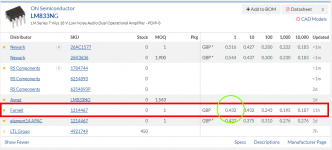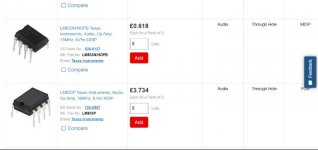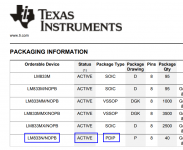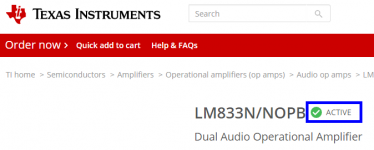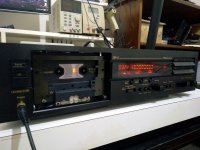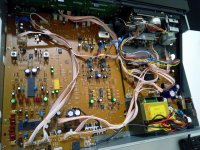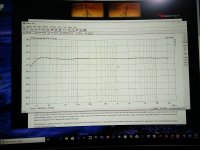Hmmmm......an interesting comment. The LM833 has very similar datasheet specs to an NE5532 (the 833 is a little quieter, the 5532 a little faster). I never could understand why Jim Williams, in his modification of the Dolby 363, used BOTH of them, each in a different part of the circuitry. The NE5532, of course, is probably the most-used fave of the pro-audio community up until ~ 2006 (when the LM4562 came out).
The Dolby 363 mod article by the late great Jim Williams can be found in REP May 1991 page 62-64
From a quick look and read he replaced a large majority of 1V/us 4558s with LM833s. The two output ones could have been stronger 4556s. Their last digit is either 6 or 8. Low res scan. In that case he could have picked 5532s for stronger mA output than LM833N. Because pro audio is high dBu levels & 600 Ohm.
My guess for all places is he simply tried chip types in a way of achieving the best stability and THD curves he could for the Dolby 363 as a whole.
Yeah, it doesn't look like the LM833 is happy at driving loads < 2KΩ, whilst the 5532 will easily drive down to 600Ω. (Stock output devices ARE 4556s). The LM833 was also probably less expensive back then as well (nowadays only 84¢ @ Mouser). I'm still going with 5532s in my upgrade, to match the rest of my tape electronics.From a quick look and read he replaced a large majority of 1V/us 4558s with LM833s. The two output ones could have been stronger 4556s. ........ he could have picked 5532s for stronger mA output than LM833N. Because pro audio is high dBu levels & 600 Ohm. My guess for all places is he simply tried chip types in a way of achieving the best stability and THD curves he could for the Dolby 363 as a whole.
Last edited:
Incidentally, did you know that the DIP LM833s are presently £3 or so at Farnell. So about the price of an OPA1612. Not sure why.
Actually £4.25 in singles. Phew!
Yeah, it doesn't look like the LM833 is happy at driving loads < 2KΩ, whilst the 5532 will easily drive down to 600Ω. (Stock output devices ARE 4556s). The LM833 was also probably less expensive back then as well (nowadays only 84¢ @ Mouser). I'm still going with 5532s in my upgrade, to match the rest of my tape electronics.
Maybe because same result but cheaper at the time, maybe the LM833s simply beat the 5532s in testing the other positions.
Main caution to rather use the original BOM is he carefully compensated with pF caps the LM833 positions. Maybe not perfectly tuned for 5532s also, or close enough to not matter.
Incidentally, did you know that the DIP LM833s are presently £3 or so at Farnell. So about the price of an OPA1612. Not sure why.
Actually £4.25 in singles. Phew!
0.71 GBP for 10+ pieces in TME Poland
I don't think so....there's a reason why the NE5532s are in most every hi-end pro audio product from the late 70s to ~2006, when the LM4562 came out. For the life of me, I cannot imagine why Dolby put in those crappy, poor-sounding New Japan Radio chips instead of the 5532s----definitely a mistake on their part, IMO.......maybe the LM833s simply beat the 5532s in testing the other positions.
Last edited:
For the life of me, I cannot imagine why Dolby put in those crappy, poor-sounding New Japan Radio chips instead of the 5532s----definitely a mistake on their part, IMO.
To avoid ringing and repeated local decoupling. Old times large boards without ground planes and many op-amps thrown around on same PSU was trouble if fast. That is why they had no comp caps even, slow op-amps security. There was a boatload of 4558 in Nakamichi decks also. And in many others. Difficult to correctly replace without decoupling and comp mods.
Octopart.com says this
_
For the LM833N Farnell either says No Longer Manufactured or No Longer Stocked. I suspect if you tried to place those orders they'd want to sell you a small outline package.
Attachments
Might have to find another supplier not named Farnell. This is what is on Texas Instruments' website today
_
To be fair it says No Longer Stocked next to the TI 833N and it's an ST Electronics 833N that is no longer manufactured.
But Farnell has been upping its prices everywhere, on all my favourite parts - if they are actually stocking them at all. It's increasingly useless and the website, which was one of the best, now is slow and increasingly frustrating.
For the life of me, I cannot imagine why Dolby put in those crappy, poor-sounding New Japan Radio chips instead of the 5532s----definitely a mistake on their part, IMO.
Dolby were not alone. I just dug up pictures from a well preserved cassette deck I was aligning some months ago. Was initially well out for heads height, azimuth, and bias. Many hours later a nice result even for a TDK-D graph (-20dB actual REC level).
The three head Nakamichi DR-2. Introduced in 1992. This is a made in Taiwan unit from 1995. Not a sharp shot but JRC proudly stamped on the eight legged bugs is still visible. Those are mainly 1V/us NJM4558. In many models including the CR-7.
They never let go of those NJM and their boosted derivatives until they stopped making decks. Even when they had the good sensibility to use low THD green bipolar Nichicons in selected places of their later years decks as seen in the photo.
Legendary Nakamichi sound is partially NJM old industrial op-amps sound as well. A historical reality.
Attachments
That's not the late great Jim Williams.The Dolby 363 mod article by the late great Jim Williams can be found in REP May 1991 page 62-64
..................................
James M. Williams was an analog circuit designer and technical author who worked for the Massachusetts Institute of Technology, Philbrick, National Semiconductor and Linear Technology Corporation
- Home
- Amplifiers
- Chip Amps
- The best sounding audio integrated opamps
